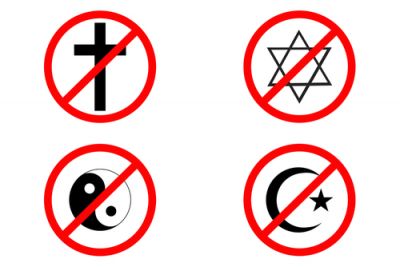 Ever since the 1990s, America has seen an increasing number of people who self-identify as a None; i.e., someone unaffiliated with any particular organized religion. Nones also include those who view themselves as agnostics or atheists. Now the newly released General Social Survey shows that Nones represent 23.1% of the US population, putting them statistically dead even with Catholics (23%) and Evangelicals (22.5%).
Ever since the 1990s, America has seen an increasing number of people who self-identify as a None; i.e., someone unaffiliated with any particular organized religion. Nones also include those who view themselves as agnostics or atheists. Now the newly released General Social Survey shows that Nones represent 23.1% of the US population, putting them statistically dead even with Catholics (23%) and Evangelicals (22.5%).
In raw numbers, these percentages translate into nearly 76 million Nones, 75.6 million Catholics, and 74 million Evangelicals based on an estimated 2019 US population of 328,900,709.
Influencing Factors
Sociologists attribute the rise of the Nones to several factors, including the following:
- Demographic changes
- Sexual revolution
- Secularization thesis
Demographics
In 2017, US age distributions ranged as follows:
- Age 0–18: 24%
- Age 19–25: 9%
- Age 26–34: 12%
- Age 35–54: 26%
- Age 44–64: 13%
- Age 65 and above: 16%
Traditionally, young people tend to be less religious than their parents, and certainly their grandparents. Consequently, it’s not surprising that a poll of millennials (those born after 1980) reveals that somewhere between 34% and 36% of them self-identify as Nones.
Sexual Revolution
Many Nones, especially the younger ones, say they base their rejection of traditional organized religion on the fact that many of these hold “retrograde attitudes” about gender identity and virtually everything else connected with the LGBT community. For instance, the United Methodist Church, America’s largest Protestant organization, is embroiled in a huge dispute over its LGBT policies, which prohibit LGBT clergy and the performance of gay marriages. Many fear that the brouhaha will lead to a breakup of the UMC into two or more factions.
Secularization Thesis
The secularization thesis holds that every industrialized society inevitably transforms from one with close identification with religious values and institutions to one with secular values and institutions. In other words, according to this theory, religion itself is doomed to eventually wither away and die.
Worldwide religious trends of the last decade, however, seem to counter or at least challenge this thesis. For instance, 80% of Americans say they believe in God or some kind of higher spiritual power. New Age spirituality is sweeping Western Europe. Fundamentalism becomes ever more prevalent in the Islamic world. Latin America is seeing an evangelical revival.
Political Significance
Whatever the precise reasons for the rise of the Nones in America, their massive defection from traditional mainline religion carries enormous political significance. Consider the fact that Evangelicals have been a major force in the Republican Party since the 1970s. They turned out in overwhelming numbers to elect Donald Trump as president in 2016, representing 26% of the electorate. They, along with Catholics and Jews, can always be counted on to show up at the polls on election day.
Nones, on the other hand, cannot be counted on to vote in mass numbers, a fact decried by Democrats since Nones strongly tend to be young liberals. Unfortunately for Democrats, however, they also apparently view voting rights per se as considerably more important than their own voting practices. Consequently, they cannot be considered a cohesive voting bloc.
Religious Phenomenon
Nones nevertheless do represent a striking religious phenomenon. Their current 76 million number not only ties with that of Catholics and Evangelicals, but far surpasses America’s Jews (4.7 million), Muslims (2.2 million), and Buddhists (1.7 million).
Keep in mind that just because someone self-identifies as a None does not mean that he or she self-identifies as an atheist or an agnostic. Obviously these two groups form a large component of the Nones, but nearly 20% of Nones report being “spiritual but not religious.”
Bottom line, the Nones, like any other group, are comprised of people with widely diversified beliefs and opinions. Consequently, perhaps their greatest impact is on the mainline religions they’re leaving in droves.



